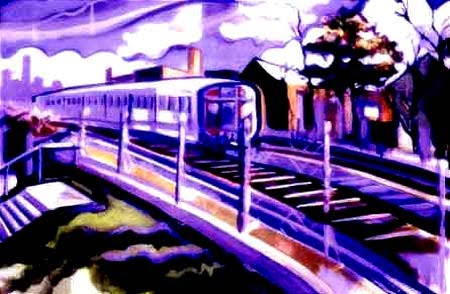Monday, June 17, 2013
Passenger Rail in Minnesota
More than three years ago when this blog was inaugurated, the initial posts focused on aspects of present and future passenger rail services and projects in California. That was due to my travel to that state – along with RAIL Magazine Editor-in-Chief Scott Bogren – for the 2010 edition of Community Transportation Magazine where we profiled transit systems across the Golden State.
In just over two weeks' time, Scott and I again will travel throughout a state visiting mobility providers – this time it will be the land of one thousand lakes: Minnesota.
In my post on the most promising regions for passenger rail over the next decade, I listed the Twin Cities at the peak position of that projection. In addition, we've discussed Minneapolis' Hiawatha line light rail, North Star commuter rail and the Saint Paul Union Depot in past editions of RAIL.
While passenger rail in the context of rail transit in the Twin Cities region indeed appears to be on solid footing, intercity rail in the larger state is less a sure thing. Currently, Amtrak's daily – and often-delayed – Empire Builder between Chicago and Seattle/Portland is the only scheduled intercity rail service in Minnesota. Although the Empire Builder has some of the highest customer service ratings in the entire Amtrak network, it arrives at Midway Station – appropriately named for its location in-between Saint Paul and Minneapolis, but hardly convenient for most of the region's population – on its westbound trek late at night, not particularly ideal for regular, reliable travel. Moreover, the train pauses for about 45 minutes in each direction to refuel and change crews, another obstacle to a robust rail corridor.
And yet, despite the state's current paucity of intercity passenger rail options, there are several encouraging projects that could transform Minnesota's ability to connect communities via passenger trains. In particular, the Zip Rail corridor – between the Twin Cities and Rochester – and the Northern Lights Express, which would link Minneapolis-St Paul with Duluth are about at the same stage of development and could connect the bulk of the state's population via frequent and reliable passenger rail service.
Zip Rail
Despite its status as the largest metropolitan area in Minnesota outside the Twin Cities region with more than 200,000 residents, the Rochester, Minn., area does not benefit from great transportation connections along the roughly 90-mile route to Minneapolis-St Paul. No direct rail lines connect the two regions and although the state's Highway 52 doesn't yet experience great congestion, it is not built to Interstate Highway levels (limited-access, grade-separated, etc). The populations of both regions are expected to grow over coming decades, requiring improved mobility connections between them.
Accordingly, Zip Rail – a coordinated effort of the Olmstead County Regional Rail Authority, the Minnesota Department of Transportation and the Federal Railroad Administration – is studying how best to institute high-capacity rail service within the corridor. The state has identified the route as a Priority 1 corridor, placing at the front of the list for state support and investment.
Current studies have focused on high-speed rail service – at speeds between 150 and 220 miles per hour – utilizing dedicated infrastructure and vehicles as the best fit for the corridor to compete with auto and air travel, while also potentially serving as the first phase of a larger high-speed rail network connecting other Midwestern destinations such as Chicago, Milwaukee, Madison and Des Moines. State transportation officials have long identified a high-speed rail link to Chicago as one of their top long-term goals, but leaders in neighboring Iowa and Wisconsin have been hesitant at best and reticent at worst to expand intercity passenger rail options in their states.
In the meantime, Minnesota could initiate high-speed rail service between the Twin Cities and Rochester – serving intrastate traffic initially – while waiting for Iowa and Wisconsin to become more comfortable with similar projects, or alternatively work with Illinois – one of the most passenger-rail friendly states in the nation – to advance the Twin Cities – Chicago corridor without the involvement of Iowa and Wisconsin, even though such a service would have to travel through at least one of those states.
As it stands today, Minnesota recently conducted a series of public meetings along the Zip Rail route in advance of the Tier I Environmental Impact Study (EIS) – a prerequisite for any large infrastructure project to move forward. A service development plan is also expected to be completed in conjunction with the EIS by the end of 2014.
Northern Lights Express
Seeking to link the Twin Cities with Minnesota's third-largest metropolitan area is the 155-mile Northern Lights Express service. While the project would likely use conventional rail equipment rather than high-speed rail infrastructure as proposed for Zip Rail, the operation will still focus on frequent trips and 110-mph service to spur $2 billion in development and encourage more than 13,000 jobs along the corridor.
The project – Joint Powers Board with participation from six counties, numerous cities and the Mille Lacs Band of Ojibwe – begin in 2007 and is currently undertaking engineering and design work supported by federal and state investment that is expected to be completed in 2015. Trains on the corridor would utilize existing BNSF Railway tracks between Duluth and The Interchange intermodal facility currently under construction in downtown Minneapolis, along with three additional on-line stations in Hinckley, Cambridge and Coon Rapids.
Stay tuned for additional Potomac Express posts – as well as tweets from @RAILMag and @CTMag1 – next week for reports from the field as RAIL Magazine travels across Minnesota...
Subscribe to:
Post Comments (Atom)







No comments:
Post a Comment